Three-phase AC provides great power density, which is commonly used for high-capacity systems and shows tremendous advantages. The power conversion between DC and three-phase AC is required for HVDC transmission systems. The wind power generation also follows such conversion stages between DC and three-phase AC, as illustrated in Fig. 8.1. The acronyms PMSG and DFIG represent the two common types of generators: the permanent magnet synchronous generator and doubly fed induction generator. Even if both directly produce three-phase AC, the AC/DC stages are required and shown as the AC side converter (ACSC) and rotor side converter (RSC). The DC link creates the path for active power to be converted and injected into the three-phase AC grid via the grid side converter (GSC). The conversion configuration adds more control functions to achieve the highest power generation, maintain the grid stability, and guarantee the power quality, regardless of the variation of the wind speed or other disturbance. FIGURE 8.1 Illustration of wind power systems using (a) PMSG; (b) DFIG. Electric motors that show high efficiency and high capacity mostly refer to the three-phase AC types. Even though the three-phase AC supply can directly power such motors, the system requires a variable frequency drive as a power interface to achieve the best performance. Figure 8.2 shows the typical back-to-back configuration of circuits for motor-driving applications. The power flow goes through the AC/DC conversion, DC link, and DC/AC conversion. The two-stage conversion of AC/DC and DC/AC is complicated since it requires a significant number of power switches. However, it provides the mechanism to achieve the best utilization of different three-phase AC motors regarding the fully controllable speed and torque. Therefore, the power conversion between DC and three-phase AC is an important subject for power electronics and system applications. FIGURE 8.2 Variable frequency drive for motors with braking resistor and chopper. The increasing utilization of batteries and renewable energy resources requires more and more DC to three-phase AC conversion to supply grids. The boom of electric vehicles (EVs) also demands high performance from the DC/AC conversion to drive electric motors. The typical bridge circuit for DC to three-phase AC conversion has been introduced in Sec. 2.4 and shown in Fig. 2.15c. The six-switch bridge shows three legs, A, B, and C, each formed by the high- and low-side active switches, as shown in Fig. 8.3. Even though the same bridge circuit is applied, the term can be different depending upon the type of applications. For example, the term “voltage source inverter (VSI)” is commonly used for motor drive applications, as illustrated in Fig. 8.3a. The term “current source inverter (CSI)” is used for interfacing power generation into the three-phase AC grid, as shown in Fig. 8.3b. The difference in modulation and operation causes the same bridge circuit to have different names, such as VSI and CSI. In this book, the active six-switch bridge is mostly discussed to avoid the confusion. IGBTs commonly are used to construct the bridge circuits for high-power ratings. FIGURE 8.3 Six-switch bridge for DC to three-phase AC conversion to support (a) AC loads; (b) grid interconnection. Following the circuit in Fig. 8.4, the six states of the switching operation and the voltage response can be defined by FIGURE 8.4 Six-switch bridge for DC to three-phase AC conversion for different load connections: (a) delta; (b) wye. • On-state of SAH ⇒ off-state of SAL ⇒ vag = Vin • On-state of SAL ⇒ off-state of SAH ⇒ vag = 0 • On-state of SBH ⇒ off-state of SBL ⇒ vbg = Vin • On-state of SBL ⇒ off-state of SBH ⇒ vag = 0 • On-state of SCH ⇒ off-state of SCL ⇒ vcg = Vin • On-state of SCL ⇒ off-state of SCH ⇒ vcg = 0 For the three-phase AC output, the load can be connected as either delta or wye, as shown in the equivalent circuits illustrated in Fig. 8.4. For the delta connection, the direct line-to-line (LL) voltage is applied to the three-phase load resistors and expressed by For the wye connection of the load, a neutral point is presented and shown in Fig. 8.4b. According to Kirchhoff’s current law (KCL), we have ia + ib + ic = 0. The voltage potential between the neutral point and the DC ground is symbolized as vng. Regarding a balanced three-phase load, the value of vng can be derived from (8.2) into (8.3). where R is the load resistance, equal for the three phases. Therefore, the line-to-neutral (LN) voltage of the three phases can be determined by (8.4). A simple modulation scheme can be created so that each active switch is switched based on the fundamental frequency of the AC output. When the 50% duty cycle for the on/off switch is applied, it refers to the 180° on-state in the phase domain. The phase delay of FIGURE 8.5 Waveforms of 180° modulation for LL voltage output. Figure 8.4b shows the case in which the three-phase load is connected across the LN voltages. Figure 8.6 illustrates the waveforms of the LN voltages, van, vbn, and vcn, where the 180° modulation is applied. The voltage between the neutral point to the DC ground is plotted, which is symbolized as vng. The voltage level in each step of van, vbn, and vcn can be determined according to (8.4). The LN voltage waveforms show four levels: FIGURE 8.6 Waveforms of 180° modulation for LN voltage output. The simple 180° modulation can operate the six-switch bridge to produce three-phase AC output. The switching frequency is the same as that of the output AC. Compared to other modulation technologies, the advantage lies in the simple switching operation and low switching frequency. The main concern is the distortion from the sine wave to represent the ideal AC signal in power systems. According to the Fourier series, the amplitude of the fundamental frequency component is computed by (8.8). Following the waveforms in Fig. 8.5, the THD level of the LL voltage is found to be 31% by using (4.24). The frequency spectrum illustrates the individual harmonic components, as shown in Fig. 8.7a. FIGURE 8.7 Harmonic spectrum of the AC voltage produced by 180° modulation: (a) LL; (b) LN. Regarding the LN voltage, as shown in Fig. 8.6, the amplitude of the fundamental frequency component can be computed by (8.9). The harmonic distribution is illustrated in Fig. 8.7b. The THD value of the LN voltage can be measured to be 22%. According to the THD analysis, the amplitude of the third-order harmonic component is zero. The dominant frequency of the harmonics is represented by the fifth-order, as shown in Fig. 8.7. Meanwhile, the harmonics with the multiple of the third order are also absent from the spectrum. The 180° modulation represents the highest voltage output based on the six-switch bridge for a DC to three-phase AC conversion. It is a simple solution, but shows high THD. The sine-triangle modulation can be applied to produce three-phase AC for higher power quality. Similar to the sinusoidal pulse width modulation (SPWM) for DC to single-phase AC, the modulation can be constructed and shown in Fig. 8.8. The technology is commonly called the three-phase SPWM. The reference signals, vra, vrb, and vrc, show the three-phase sinusoidal waveforms indicating the phase difference of FIGURE 8.8 Principle of sine-triangle modulation for DC to three-phase AC.
CHAPTER 8

Conversion Between Three-Phase AC and DC
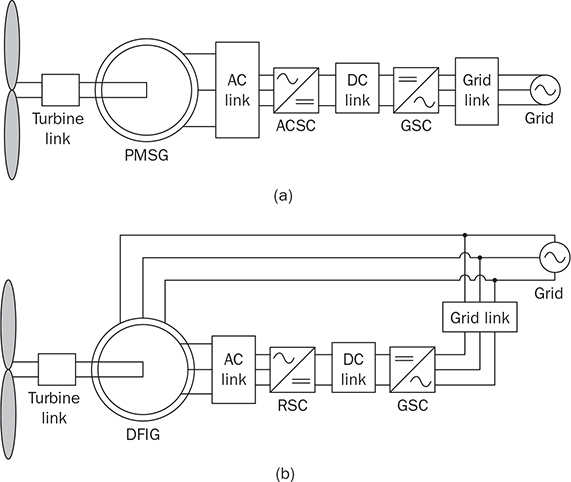
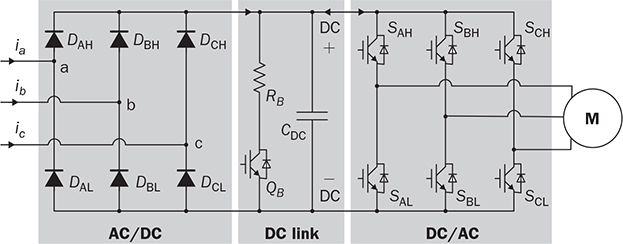
8.1 DC/AC Conversion
8.1.1 Bridge and Switching Operation
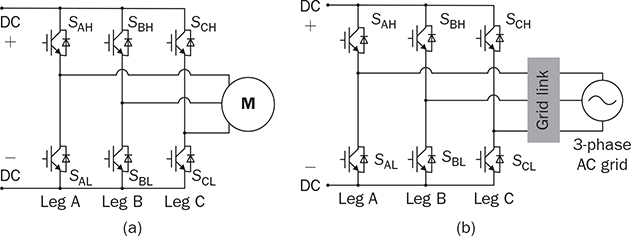
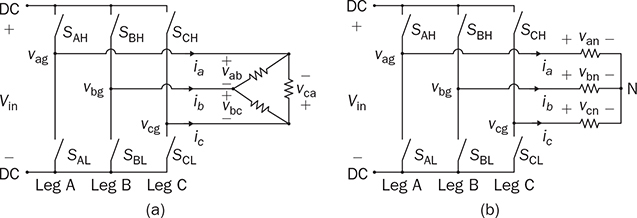




8.1.2 180°Modulation
 or 120° should be applied among the three phases, namely, A, B, and C. Figure 8.5 demonstrates the three-phase waveforms regarding the voltages of vag, vbg, vcg, vab, vbc, and vca, which are produced by the 180° modulation. All variables are referred to in Fig. 8.4a. Following the waveform of vab in Fig. 8.5, the root-mean-square (RMS) value can be determined by (8.5), where
or 120° should be applied among the three phases, namely, A, B, and C. Figure 8.5 demonstrates the three-phase waveforms regarding the voltages of vag, vbg, vcg, vab, vbc, and vca, which are produced by the 180° modulation. All variables are referred to in Fig. 8.4a. Following the waveform of vab in Fig. 8.5, the root-mean-square (RMS) value can be determined by (8.5), where  . The same RMS computation is applied to another two LL voltages.
. The same RMS computation is applied to another two LL voltages.

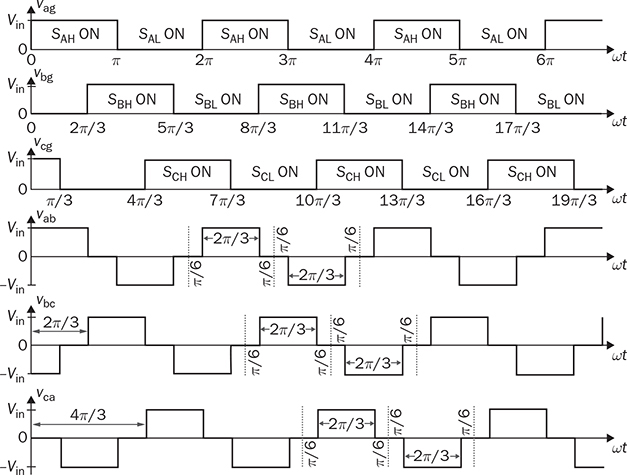
 Vin,
Vin,  . Six steps of the LN voltage appear and are distributed equally in each 2π cycle. The RMS value can be computed by (8.6). It can also be derived by (8.7) when the RMS value of the LL voltages is available.
. Six steps of the LN voltage appear and are distributed equally in each 2π cycle. The RMS value can be computed by (8.6). It can also be derived by (8.7) when the RMS value of the LL voltages is available.
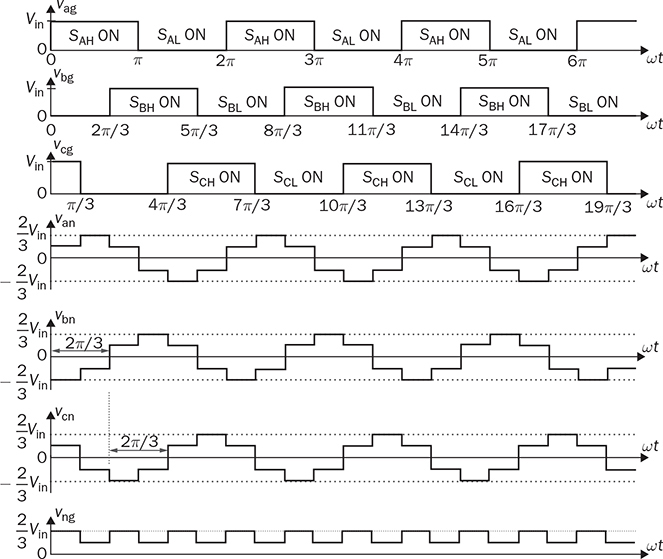


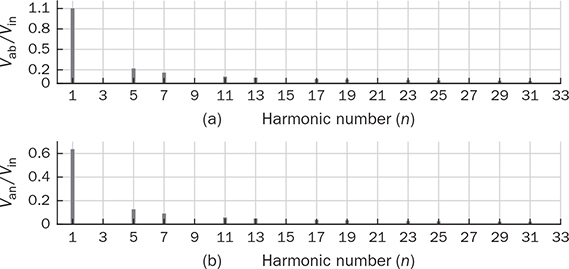


8.1.3 Sine-Triangle Modulation
 . Each is assigned to the amplitude, ma, and fundamental frequency, ω. Therefore, the math ematical expressions are: vra = ma sin(ωt), vrb = ma
. Each is assigned to the amplitude, ma, and fundamental frequency, ω. Therefore, the math ematical expressions are: vra = ma sin(ωt), vrb = ma  ), vrc = ma
), vrc = ma  ). The carrier signal, vc, is a triangle wave with the peak-to-peak amplitude of ±1 and
). The carrier signal, vc, is a triangle wave with the peak-to-peak amplitude of ±1 and  . The ma and mf represent the modulation indexes for the output amplitude and switching frequency.
. The ma and mf represent the modulation indexes for the output amplitude and switching frequency.
